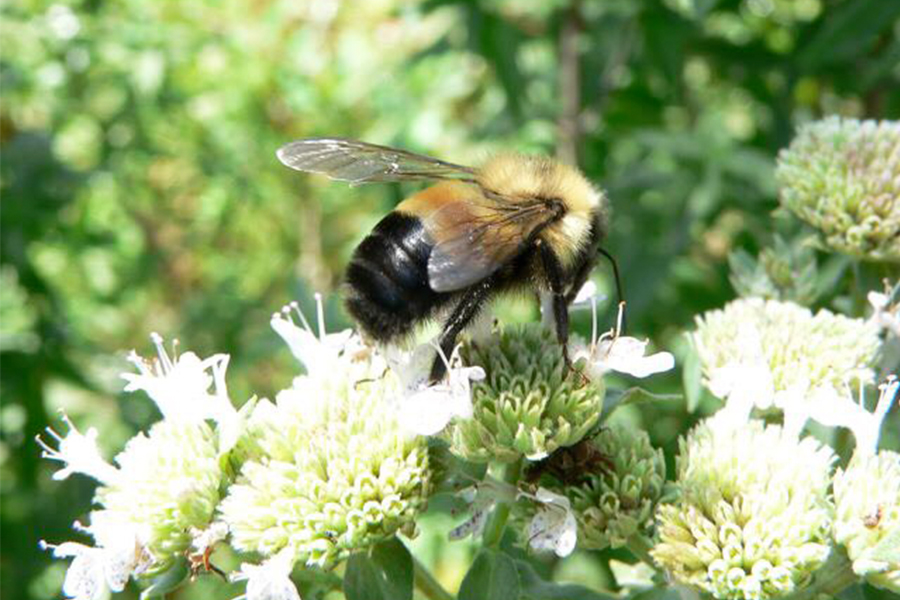
U.S. Fish and Wildlife Service list the first ever bumblebee in continental United States as endangered; recovery plan in progress
The famous black and yellow rusty patched bumblebee is at risk of extinction, and it was recently listed as an endangered species by the U.S. Fish and Wildlife Service (USFWS).
UC Davis professor emeritus Robbin Thorp of the Department of Entomology and Nematology was a key actor in in the process of labeling the bee as endangered.
Thorp co-authored a petition in 2010 to call for the endangered status of the rusty patched bumblebee, species name bombus affinis. Several service programs are underway to collaborate with partners such as the North American Pollinator Protection Campaign to help restore general pollinators and their habitats.
“It had been a very common bee in western United States, but surveys done in early 2000s showed it had just disappeared from its original habitat,” Thorp said.
The bombus affinis live in colonies that include a queen bee and female worker bees. Male bees and other queens are produced during the late spring as part of the annual cycle of the colony.
“Only the queen survives for an entire year, with most members of the colony only living a few weeks,” said John Mola, a Ph.D. candidate at Williams Lab at Davis and part of the Davis graduate group of ecology.
The worker and male bees have rusty-colored patches on the center of their backs, hence their nickname: the rusty patched bumblebee.
“[Endangerment to bombus affinis is caused by] habitat loss because we convert land [for] cities and agricultural uses,” Thorp said. “This tends not to support bees and they have a loss of flowering plants for food and nesting.”
The declining population of bombus affinis can also be attributed to reduced genetic diversity, high levels of fungal infection and pesticides and insecticides used in agricultural production.
“The U.S. Fish and Wildlife Service has now recognized the role neonicotinoid insecticides play in the decline of bee populations,” said Sarina Jepsen, the director of endangered species for the Xerces Society, a nonprofit invertebrate conservation group.
Toxins used in pesticides can be directly absorbed through a bee’s exoskeleton from contaminated nectar and pollen. Rusty patched bees risk additional contamination from chemicals in soils, often the location of nesting zones for this organism.
“When a species is protected, it becomes illegal to do [things] that might further cause harm to it,” Jepsen said. “Regulations exist and can impact a range of human activity, from approving a pesticide to building a new road or structure.”
The rusty patched bumble bee can be found in the eastern United States in Maine and southward, stretching down to Georgia and all the way across the midwest into the western states, according to USFWS.
The bees like to live in grasslands and prairies — areas that provide nectar and pollen from flowers. In addition, these areas provide nesting sites for the bees and undisturbed soil for hibernating queens. However, commercialization use of bees for agricultural purposes today has led to a dramatic change in the wild population.
“Bumble bees were commercialized in the 1980s and a disease spread among the population into the wild population of our bees,” Thorp said. “Other species may be carriers but not affected like the rusty patch bumblebee.”
Bees are vital to agriculture, serving as essential pollinators to various kinds of plants.
In fact, bees contribute to pollinating about 85 percent of all flowering plants. Reproduction of plants requires pollination and many plants could not achieve this without the help of bees.
“Bumblebees are some of the dominant pollinators in colder climates — hence their fat and fuzzy bodies — pollinating charismatic and beautiful spring wildflowers like lupines, delphinium and clovers,” Mola said.
When a bee lands on a flower, it picks up pollen on its legs and body from the male part of a plant, called stamen. As the bee travels from flower to flower, the pollen is transferred from the bee to the female part of another flower, called stigma.
This process allows fertilization to occur, so a plant may produce fruit, carrying seeds and can develop. Examples of bee-pollinated crops include blueberries, cranberries, almonds, watermelon, cantaloupe, citrus fruits and apples.
“Some of these bees pollinate our own crops, and help with our national food production,” Thorp said. “A significant example would be bees pollinating greenhouse grown tomato plants.”
If bees went extinct, the berries, seeds and fruits that other wildlife depend on would be detrimental. The impact is not solely on agricultural food for human consumption.
“Bumblebees were previously called ‘humblebees,’ and before that, they were called
“Dumbledores,” Mola said. “[Apparently] J.K. Rowling, [author of the Harry Potter series] named Albus Dumbledore after bumblebees because supposedly he’s always humming about.”
While only one bee, bombus affinis, is listed under the Endangered Species Act, many bee experts hope this will bring awareness to the threats against bee populations in general.
“If folks want to help conserve bee populations, the best thing they can do is plant a flower garden rich in pollen and nectar for as much of the growing season as possible,” Mola said.
The USFWS has additional information about getting involved with the conservation of the rusty patched bumblebee, including tips on gardening and landscaping as well as minimizing use of toxic pesticides.
“Becoming aware of the roles that other organisms play in our environment, no matter how tiny, can help us better understand the ecosystems around us,” Thorp said.
Written by Shivani Kamal — science@theaggie.org



